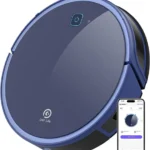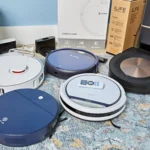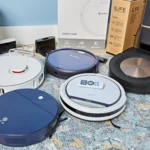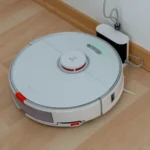As technology continues to improve, everyday household chores are becoming easier and more automated. One such example is the smart vacuum cleaner, a device that has revolutionized the world of cleaning. With the ability to navigate and clean floors without human intervention, smart vacuum cleaners have become a popular addition to many homes. However, with so many options available, it can be challenging to determine which factors affect their performance. In this article, we will explore the key factors that can impact the performance of your smart vacuum cleaner and provide tips on how to optimize its effectiveness.
Factors that Affect the Performance of Smart Vacuum Cleaners
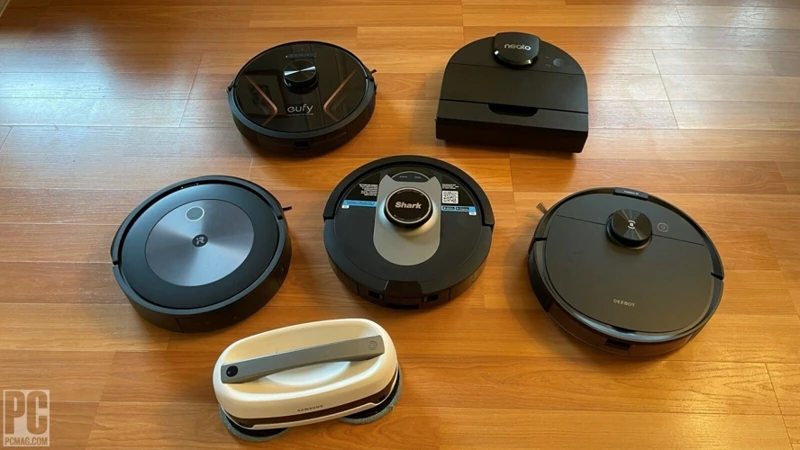
Smart vacuum cleaners have become increasingly popular over the years because of their ability to automate cleaning tasks in homes and offices. These innovative machines come with different features that are designed to enhance their performance. However, several factors can affect the performance of smart vacuum cleaners. Understanding these factors is essential for users to get the best out of their machines. In this article, we will highlight the various factors that affect the performance of smart vacuum cleaners, with tips on how to optimize their performance. So whether you are looking to purchase a new smart vacuum cleaner or improve the performance of your current one, this article will be useful. Let’s dive in!Check our article about factors affecting the performance of smart vacuum cleaners
Sensor Technology
Smart vacuum cleaners are equipped with cutting-edge sensor technology that enables them to navigate efficiently around your home’s floors, carpets, and furniture. The effectiveness of the sensor technology used in these devices is a crucial factor in their overall performance.
Here are some ways in which sensor technology can affect the performance of your smart vacuum cleaner:
- Mapping: Some of the best smart vacuums use sensors to create a map of your home, allowing them to clean systematically and avoid bumping into obstacles unnecessarily.
- Obstacle Detection: Sensors also enable smart vacuums to detect obstacles in their path, allowing them to change direction or even climb minor obstacles as needed.
- Floor Detection: Smart sensors can detect the type of flooring below the vacuum and adjust suction power accordingly, ensuring effective cleaning on all surfaces.
- Boundary Sensing: Many smart vacuum cleaners can use sensors to detect room boundaries or other no-go zones, keeping them out of areas where they can get stuck or tangled.
It’s important to choose a smart vacuum cleaner that uses advanced sensor technology, as this can significantly improve its performance. To learn more about choosing the right smart vacuum for your needs and budget, check out our in-depth guide here.
Additionally, once you’ve chosen your smart vacuum, it’s important to ensure that it is properly maintained to optimize its performance. For tips on how to do this, check out our guide on improving smart vacuum cleaner performance.
Battery Life
One of the most critical factors affecting the performance of a smart vacuum cleaner is its battery life. It is essential to have a reliable and long-lasting battery to ensure that the cleaner operates efficiently and cleans your house effectively without interruptions or downtime.
Smart vacuum cleaners can have different battery life depending on the manufacturer, model, and cleaning modes. In general, robot vacuum cleaners have smaller batteries than regular vacuum cleaners, but they can still offer a decent run time. Most robot vacuum cleaners have lithium-ion batteries, which are known for their long life and low discharge rates.
In the table below, we have listed some popular smart vacuum cleaners and their battery life:
| Vacuum Cleaner Model | Battery Life |
|---|---|
| iRobot Roomba i7+ | up to 75 minutes |
| Shark IQ Robot Self-Empty XL | up to 90 minutes |
| Eufy RoboVac G30 Verge | up to 100 minutes |
| Ecovacs Deebot Ozmo T8 AIVI | up to 180 minutes |
As you can see, the battery life varies from one model to another. Some models offer shorter battery life, while others can run for up to three hours before needing a recharge. It is important to consider the battery life when choosing a smart vacuum cleaner that best fits your needs.
To optimize the battery life of your smart vacuum cleaner, it is recommended to keep the battery charged and avoid overcharging it. Most smart vacuums can automatically return to their charging dock when their battery is low, but it is always best to keep an eye on the battery level and recharge it as needed.
By choosing a smart vacuum cleaner with a long-lasting battery, you can save time and effort while keeping your home clean and tidy. Check out our best smart vacuum guide to find the perfect vacuum for your home at the best price-performing ratio in the market.
Cleaning Mechanism
One of the most important factors affecting the performance of smart vacuum cleaners is their cleaning mechanism. Here are some different types of cleaning mechanisms that are being used in various models of smart vacuum cleaners:
- Rotating Brush Rollers: These are ideal for cleaning carpets, as they can easily loosen debris and dirt from the carpet fibers, making it easier for the vacuum cleaner to suction them up.
- Suction Power: Vacuum cleaners with strong suction power are great at cleaning hard floors and carpets.
- Side Brushes: These brushes are used to sweep dirt and debris from edges and corners, ensuring that every nook and cranny is thoroughly cleaned.
- Mop Cleaning: Some smart vacuum cleaners also come with a mop feature, allowing them to wet-clean floors as they vacuum.
- UV Sterilization: A few high-end vacuum cleaners come with a UV sterilization feature, which kills bacteria and germs as they clean.
- Self-Emptying Bins: Some smart vacuum cleaners can empty their own dustbins, eliminating the need for the user to do so.
Each cleaning mechanism has its own strengths and weaknesses, and it’s important to choose a smart vacuum cleaner that has the right cleaning mechanism for your needs. For instance, if you have mostly hardwood or tile floors, you might prioritize suction power over brush rollers. On the other hand, if you have a lot of carpeted areas in your home, you might want a vacuum cleaner with strong brush rollers.
It’s also essential to keep the cleaning mechanism of your smart vacuum cleaner in good condition. Regularly checking and cleaning the brushes, filters, and other components will ensure that your vacuum cleaner is functioning optimally and providing the best possible cleaning performance.
To learn more about the price-performance of smart vacuum cleaners, check out our related article: Price-Performance Comparison of Smart Vacuum Cleaners.
Dustbin Size
The size of the dustbin is an important factor in the performance of a smart vacuum cleaner. If the dustbin is too small, it will fill up quickly and reduce the efficiency of the vacuum. On the other hand, if it is too large, the vacuum cleaner may become bulky and difficult to maneuver.
To ensure optimal performance, choose a smart vacuum cleaner with a dustbin size that is appropriate for your home’s size and cleaning needs. A larger dustbin may be necessary for a larger home, for households with pets or for those with high traffic areas that require frequent cleaning.
Here are some of the benefits of a larger dustbin size:
- Efficient Cleaning: With a larger dustbin, the vacuum cleaner will be able to pick up more debris before it needs to be emptied. This means more efficient cleaning and fewer interruptions during your cleaning sessions.
- Convenience: A larger dustbin is more convenient because it requires less frequent emptying. This is especially true if you have a busy schedule and limited time for cleaning.
- Cleaner Air: A larger dustbin means that the vacuum cleaner can capture more dust and allergens, resulting in cleaner air quality in your home.
- Less Maintenance: With a larger dustbin, you won’t have to spend as much time emptying and cleaning the bin. This means less maintenance and more time for other activities.
The dustbin size is an important factor to consider when purchasing a smart vacuum cleaner. A larger dustbin offers several benefits, including efficient cleaning, convenience, cleaner air, and less maintenance. Choose a vacuum cleaner with a dustbin size that is appropriate for your home’s cleaning needs, and enjoy a cleaner and more comfortable living space.
Filtration System
The filtration system of a smart vacuum cleaner is a critical component that impacts its performance. A high-quality filtration system not only traps dirt, dust, and other allergens, but also improves indoor air quality. A poorly designed filtration system can result in decreased suction power and can even release dust and allergens back into the air, making matters worse. Here are some factors to consider when evaluating the filtration system of a smart vacuum cleaner:
- Type of Filter: Smart vacuum cleaners include different types of filters such as HEPA, foam, and mesh filters. HEPA filters are considered to be the most effective in trapping small particles like allergens, viruses and bacteria, and other pollutants. A foam filter is easy to clean and maintain, while a mesh filter is the least expensive option but may need to be replaced more often.
- Number of Filters: Some smart vacuum cleaners come with a dual filtration system that includes a pre-filter and a main filter. A pre-filter traps larger particles like dust and hair, while the main filter targets smaller particles. The advantage of having a dual filtration system is that the main filter lasts longer since it’s not exposed to as much dirt and debris.
- Efficiency of Filter: The efficiency of a filter is indicated by its Minimum Efficiency Reporting Value (MERV) rating. A higher MERV rating means that the filter is more effective in trapping small particles. The ideal MERV rating for a smart vacuum cleaner is between 11 and 13. Anything higher than that may cause the vacuum cleaner to work harder, leading to decreased suction power.
- Clogging Prevention: Over time, filters can become clogged with dirt and debris, which can reduce suction power. Some smart vacuum cleaners include anti-clogging technology that prevents dirt from sticking to the filter, ensuring optimal suction power.
To ensure that your smart vacuum cleaner’s filtration system is performing optimally, you should regularly clean and replace the filters. The frequency with which you need to clean or replace the filters will depend on the type of filter and the amount of use. A well-maintained filtration system will not only improve the performance of your smart vacuum cleaner, but it will also improve your indoor air quality.
Navigation System
The navigation system is a crucial factor that affects the overall performance of smart vacuum cleaners. It is responsible for directing the vacuum cleaner to move around and thoroughly clean the designated area. A navigation system works by using various sensors and technologies that enable the device to perceive its surroundings and map the cleaning area.
One of the most common technologies used in navigation systems is LiDAR (Light Detection and Ranging). LiDAR works by emitting laser beams and measuring the time it takes for the beams to reflect back, creating a 3D map of the environment. Another popular technology is SLAM (Simultaneous Localization and Mapping) which uses a combination of sensors such as cameras, sonar, and gyroscopes to create a map of the cleaning area.
Table 1: Pros and cons of Navigation Systems
| Navigation System | Pros | Cons |
|---|---|---|
| LiDAR | Accurate mapping, can work in the dark, covers large areas | Expensive, limited battery life |
| SLAM | Adapts to changing environments, cost-effective | Can be affected by low light, less accurate mapping |
| VSLAM | Combines benefits of LiDAR and SLAM, accurate mapping, can work in the dark | Expensive, limited battery life |
Each navigation system has its advantages and disadvantages, as shown in Table 1. LiDAR provides accurate mapping but can be expensive and has limited battery life. SLAM may not work effectively in low light conditions but is cost-effective. Visual SLAM (VSLAM) combines the benefits of LiDAR and SLAM, providing accurate mapping and the ability to work in low light conditions, albeit at a higher price point.
The navigation system plays a pivotal role in ensuring that smart vacuum cleaners can efficiently traverse spaces, avoiding obstacles, while covering all areas. It is important to consider the cleaning area’s size and layout when selecting a smart vacuum cleaner with the right navigation system.
Brush Rollers
One of the most important components of a smart vacuum cleaner is its brush rollers. These are the cylindrical brushes located underneath the vacuum cleaner that sweep the floor and collect dirt and debris. The quality and design of brush rollers can significantly affect the performance of a smart vacuum cleaner. Here are some factors to consider when it comes to brush rollers:
- Bristle Material: The material of the bristles on the brush rollers can affect its ability to pick up dirt and hair. Most vacuum cleaners come with nylon bristles, which are suitable for most surfaces. However, if you have a lot of pet hair, you may want to consider a vacuum cleaner with silicone or rubber bristles as they can pick up hair more effectively.
- Brush Roller Design: The brush roller design can also influence performance. Some vacuum cleaners have brush rollers with straight bristles while others have spiraled bristles. Spiraled bristles are more effective at agitating and picking up dirt and debris, making them a better option for carpets.
- Height Adjustability: Some vacuum cleaners have adjustable brush rollers, which allow you to set the height according to the type of flooring you have. This feature can prevent damage to your floors and improve the overall cleaning performance.
- Cleaning Frequency: It’s important to clean the brush rollers regularly to prevent clogging and maintain performance. Some vacuum cleaners come with detachable brush rollers that are easy to clean, while others have non-detachable rollers that require more effort to clean.
The material, design, height adjustability, and cleaning frequency of brush rollers are all factors that can affect the performance of a smart vacuum cleaner. When choosing a smart vacuum cleaner, be sure to consider these factors to ensure optimal cleaning performance.
Size and Design
The size and design of a smart vacuum cleaner play a crucial role in its performance. The size of the machine determines its ability to clean areas effectively and efficiently. A smaller vacuum cleaner might work wonders for a small apartment, but it might not be ideal for a large home or commercial space.
On the other hand, a larger vacuum cleaner might have more powerful suction capabilities, but it might be difficult to maneuver and store. It is essential to consider the size of the vacuum cleaner based on the area it is intended to clean.
In terms of design, a well-designed vacuum cleaner can enhance cleaning performance. A sleek design with fewer obstacles to the suction path can improve the machine’s ability to collect dirt and debris. Additionally, a good design can make the vacuum cleaner more attractive and comfortable to use.
Below is a table summarizing how the size and design can affect the performance of a smart vacuum cleaner:
| Aspect | Impact on Performance |
|---|---|
| Size | The size of the vacuum cleaner determines the area it can clean well. A small vacuum cleaner might clean a small house but might not be suitable for larger spaces. A larger vacuum cleaner might work better for bigger areas, but it might be challenging to maneuver. |
| Design | The design of the vacuum cleaner impacts its effectiveness in picking up dirt and debris. Good design with fewer obstacles in the suction path can improve the vacuum cleaner’s performance by helping it collect more dirt and debris in less time. A sleek design can also make it more attractive and convenient to use. |
Ultimately, it is crucial to consider both the size and design of the vacuum cleaner when selecting one for your home or business. Ensuring that it is suitable for the intended space and has an efficient design will help to optimize its performance.
How to Optimize the Performance of Your Smart Vacuum Cleaner
Now that we know the different factors that can affect the performance of smart vacuum cleaners, it’s time to look at how we can optimize their functioning. Keeping your device in top shape will not only enhance its productivity but also extend its lifespan. By following these simple tips and tricks, you can ensure that your smart vacuum cleaner is running at its peak potential. Let’s dive in and explore some ways you can optimize the performance of your smart vacuum cleaner.
Regular Maintenance
Maintaining your smart vacuum cleaner is essential in ensuring its optimal performance. Regular maintenance not only improves the efficiency of its cleaning but also helps prolong the lifespan of the machine. Here are some important maintenance tasks that should be performed regularly:
| Maintenance Task | Frequency |
|---|---|
| Cleaning the Brush Rollers | After every use |
| Emptying the Dustbin | After every use |
| Checking Air Filters | Weekly |
| Cleaning the Sensors | Weekly |
| Wiping Down the Exterior | Monthly |
Cleaning the brush rollers is important because dirt and hair can accumulate on the bristles, impeding their movement and reducing the effectiveness of your vacuum cleaner. Emptying the dustbin is also important as a full dustbin can reduce the suction power of the machine. Checking and cleaning the air filters is essential to ensure good air quality and prevent dust and dirt from escaping the vacuum. Finally, wiping down the exterior of the machine monthly helps to keep it looking and functioning like new.
Performing these maintenance tasks on a regular basis can help to optimize the performance of your smart vacuum cleaner, ensuring it cleans your home quickly and thoroughly, while also extending the life of the machine.
Optimal Usage
Maximizing the usage of your smart vacuum cleaner is essential to getting the most out of its performance. Here are some tips and tricks to optimize the usage of your smart vacuum cleaner:
| Tips for Optimal Usage |
|---|
| 1. Map out your cleaning area: Before starting the cleaning process, make sure to map out the cleaning area to ensure that the smart vacuum cleaner has cleaned every corner of your home. |
| 2. Remove obstacles: Clear out any obstacles such as toys, cables or rugs, that may prevent the smart vacuum cleaner from cleaning your desired area. |
| 3. Keep floors clear: Make sure that the floor is clear of any clutter or debris to prevent the smart vacuum cleaner from getting stuck or damaged during the cleaning process. |
| 4. Schedule cleaning: Set a regular schedule for your smart vacuum cleaner to ensure that your floors are always clean and free of dust and dirt. |
| 5. Use the right cleaning mode: Select the appropriate cleaning mode, such as spot cleaning, edge cleaning or continuous cleaning, depending on the level of cleaning required for the specific area. |
| 6. Use virtual barriers: Create virtual barriers to prevent the smart vacuum cleaner from entering certain areas or rooms that you do not want to be cleaned. |
By following these best practices, you can ensure optimal usage of your smart vacuum cleaner, leading to better performance and cleaner floors.
Effective Scheduling
Scheduling is an important aspect of maintaining the performance of your smart vacuum cleaner. Most of the latest smart vacuum cleaners come with a scheduling feature where you can set up the device to clean your home at specific times without manually starting it every time.
Why is scheduling important?
Scheduling your smart vacuum cleaner ensures that your home stays clean and dust-free even when you are not around. By setting up a regular schedule, you don’t have to worry about manually starting the device each time you want to clean.
Scheduling can also help maintain battery life. Most smart vacuum cleaners come with an automatic charging feature. Scheduling the device to clean and recharge at set intervals can help maximize its battery life and ensure that it is always ready to clean.
How to schedule your smart vacuum cleaner?
To schedule your smart vacuum cleaner, follow these simple steps:
| Step | Description |
|---|---|
| Step 1 | Open the app on your smartphone or tablet that is connected to your smart vacuum cleaner. |
| Step 2 | Look for the scheduling or timer setting option. |
| Step 3 | Select the days and specific time you want the device to clean your home. |
| Step 4 | Save the settings and wait for the device to start cleaning according to your schedule. |
Tips for effective scheduling
To optimize the performance of your smart vacuum cleaner, here are some tips for effective scheduling:
- Choose the right time: Set the device to clean your home when you are not around, such as in the morning when you are at work or at night when you are asleep. This way, you won’t be disturbed by the device’s noise, and it can clean undisturbed.
- Adjust the schedule according to weather: If you live in areas with a lot of dust and pollen, you may need to adjust the cleaning schedule accordingly.
- Clean or replace filters: Make sure to clean or replace the filters regularly to ensure your device’s suction power is maintained.
By following these tips for effective scheduling and properly maintaining your smart vacuum cleaner, you can ensure that it continues to perform at its best and keep your home clean and tidy.
Smart Home Integration
Smart home integration is one of the most sought-after features in modern smart vacuum cleaners. With this feature, you can connect your vacuum cleaner to your home’s Wi-Fi network and then control it remotely through a mobile app or voice commands. But how does this integration affect the performance of your smart vacuum cleaner? Let’s take a look.
Convenience – Smart home integration makes it extremely convenient to control your smart vacuum cleaner. With the touch of a button on your smartphone, you can start, stop or schedule cleaning, monitor battery life and cleaning status, and even receive alerts when the dustbin is full. As technology advances, more and more vacuum cleaners are being designed with compatibility with Google Assistant, Alexa, and other voice-activated devices. This makes it easier for you to command your cleaner without even lifting a finger.
Efficiency – Smart home integration brings in a new level of efficiency to your cleaning schedule. As mentioned, you can schedule your vacuum cleaner to start cleaning at a specific time or even to clean a particular room. This level of precision reduces the use of energy, and with the integration of mapping technology, cleaning can be done seamlessly without any repetition or leaving spots.
Adaptability – With the power of smart home integration, vacuum cleaners are becoming more adaptable to the needs of the user. You can customize your cleaning patterns and adjust the suction power based on your floor’s cleaning needs. With the power to modify your machines performance, you’ll enjoy cleaning the floors, carpets and pet hair with high efficiency and consistent results.
Compatibility – Most vacuum cleaners that have smart home integration systems built into them, are usually compatible with most brands and models. Depending on the backend technology used by such devices, it could either be compatible only within the same brand or with universal technologies like Wi-Fi, Bluetooth, and ZWave. When you decide on purchasing a vacuum cleaner, you can factor in the smart home device that you own and select a model that seamlessly fits in with your existing setup.
Smart home integration offers you the ability to customize your cleaning at your convenience. However, it is important to keep in mind that efficient and effective cleaning goes hand in hand with the power of the robot, the quality of brushes and nozzles, the battery life, and the size of the dustbin. When buying a vacuum cleaner, it is important to consider all of these factors for optimal performance.
Conclusion
After exploring the various factors that affect the performance of smart vacuum cleaners, it is clear that finding the perfect vacuum to suit your specific needs can be a daunting task. From sensor technology to battery life, each aspect plays a crucial role in determining how efficient and effective the cleaning process will be.
However, with the proper information and insight, you can easily optimize the performance of your smart vacuum cleaner. By regularly maintaining your device, utilizing it in the most effective manner, scheduling cleaning sessions appropriately, and integrating with your smart home technology, you can ensure a top-notch performance every time.
In order to make the best purchasing decision, it is important to carefully assess your needs and preferences to determine which factors are most important to you. With a wide range of options on the market, there is sure to be a smart vacuum cleaner out there that will meet all of your cleaning needs and exceed your expectations.
Overall, smart vacuum cleaners have revolutionized the cleaning industry by providing a convenient and efficient cleaning solution for homeowners. With their advanced technology and features, they have made it easier than ever before to keep your home clean without any hassle. So why not invest in a smart vacuum cleaner for your household and experience the benefits for yourself?
Frequently Asked Questions
What is a smart vacuum cleaner?
A smart vacuum cleaner is an automated cleaning device that navigates its way around your home using a variety of sensor and mapping technologies. It is designed to make your cleaning process easier and more efficient.
What are the factors that affect the performance of a smart vacuum cleaner?
There are several factors that affect the performance of a smart vacuum cleaner such as sensor technology, battery life, cleaning mechanism, dustbin size, filtration system, navigation system, brush rollers, and size and design.
What is the best sensor technology for a smart vacuum cleaner?
One of the most effective and advanced sensor technologies for smart vacuum cleaners is laser-based LIDAR (Light Detection and Ranging). It creates a detailed map of your home to make cleaning more efficient.
How important is the battery life of a smart vacuum cleaner?
The battery life of a smart vacuum cleaner is extremely important, as it determines how long the device can run between charges. A longer battery life ensures that the device can clean a larger area or do multiple cleaning sessions in one charge.
What is the dustbin size and why is it important?
The dustbin size is the amount of debris and dirt that a smart vacuum cleaner can hold before it needs to be emptied. A larger dustbin size means less frequent emptying and more efficient cleaning.
What type of filtration system should a smart vacuum cleaner have?
A high-efficiency particulate air (HEPA) filtration system is the most effective type of filtration system for a smart vacuum cleaner. It removes small particles and allergens from the air, reducing the risk of allergies and respiratory issues.
What is the best navigation system for a smart vacuum cleaner?
An advanced navigation system that uses mapping, sensors, and algorithms to navigate your home is the best option. This will ensure that the device covers the entire area and avoids obstacles.
What is the importance of brush rollers in a smart vacuum cleaner?
Brush rollers are responsible for agitating and lifting dirt, debris, and pet hair from carpets and floors. They are vital components of smart vacuum cleaners as they ensure thorough cleaning.
How do you optimize the performance of your smart vacuum cleaner?
You can optimize the performance of your smart vacuum cleaner by regularly maintaining it, optimizing its usage, scheduling cleaning sessions, and integrating it with your smart home system.
Are there any other benefits of using a smart vacuum cleaner?
Yes, there are several benefits of using a smart vacuum cleaner such as reducing the need for manual cleaning, saving time and effort, and improving indoor air quality.

